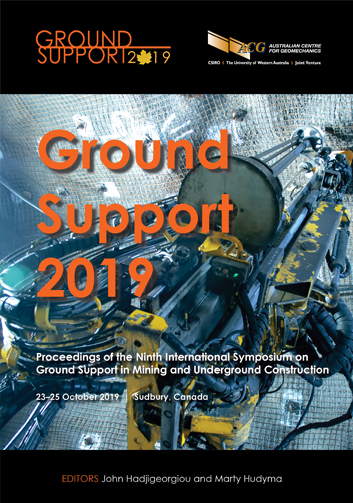Ground support selection rationale: a Gold Fields perspective

|
Authors: Andrews, PG |
DOI https://doi.org/10.36487/ACG_rep/1925_0.02_Andrews
Cite As:
Andrews, PG 2019, 'Ground support selection rationale: a Gold Fields perspective', in J Hadjigeorgiou & M Hudyma (eds), Ground Support 2019: Proceedings of the Ninth International Symposium on Ground Support in Mining and Underground Construction, Australian Centre for Geomechanics, Perth, pp. 15-28, https://doi.org/10.36487/ACG_rep/1925_0.02_Andrews
Abstract:
Gold Fields Limited is a globally diversified gold producer with eight operating mines and projects in Australia, Ghana, Peru and South Africa, and a total attributable annual gold-equivalent production of approximately 2.2 million ounces. Of the six Gold Fields underground operations, five are based in Australia at Granny Smith (Wallaby mine), Agnew (New Holland and Waroonga mines), St Ives (Hamlet and Invincible mines), and in one in South Africa (South Deep mine). All operations undertake a ground support review every two to three years as part of tendering processes, but also review support if conditions change. In all operations ground support is defined as the sum of all components, these being the rock reinforcement (bolts), and surface support (mesh or fibrecrete). These underground operations range in depth from 250 to 3,000 m below surface. The rock types encountered at these operations range from weak mudstones and ultramafic units (<25 MPa) to very strong igneous rocks and metasediments (>250 MPa). Therefore, rock mass conditions ranging from pristine ground conditions, through squeezing ground conditions, to seismically active ground conditions, are experienced depending on the operation. An important variable when choosing the correct ground support is the change in rock mass conditions over time. Ultimately, the chosen ground support must be able to work in a variety of conditions over the life of the support. In addition to ground conditions, there are several other factors influencing ground support selection including expected load capacity in both static and dynamic situations, corrosion rates, type of equipment required for installation, installation cycle time, and cost. Due to all these factors, the process of selecting the appropriate support can be time consuming and potentially costly. Once all the above factors have been considered, the final phase of product testing can be undertaken. The final phase of support selection is both off-site and on-site trials including static and dynamic testing, cycle times, ease of installation, and observations on support performance This paper will outline the final phase of ground support selection used to determine the appropriate support regimes at two mines covering firstly, squeezing ground, and secondly, seismically active, deep, highstress ground conditions.
Keywords: ground support, dynamic conditions, squeezing ground
References:
Mercier-Langevin, F & Hadjigeorgiou, J 2011, ‘Towards a better understanding of squeezing potential in hard rock mines’, Mining Technology Journal, vol. 120, no. 1, pp. 36–44.
Sandy, MP, Gibson, W & Gaudreau, D 2007, ‘Canadian and Australian ground support practices in high deformation environments’, in Y Potvin (ed.), Proceedings of the Fourth International Seminar on Deep and High Stress Mining, Australian Centre for Geomechanics, Perth, pp. 297–312.
Voyzelle, B & Anderson, T 2015, Laboratory Testing of Static and Dynamic Behaviours of Garock Hybrid Bolts, Project Report #: P002180.001, CMIN 2015-2658-RE.
Watson, BP, Pretorius, W, Mpunzi, P, Du Plooy, M, Matthysen, K & Kuijpers, JS 2014, ‘Design and positive financial impact of crush pillars on mechanised deep-level mining at South Deep Gold Mine’, Journal of the Southern African Institute of Mining and Metallurgy, vol. 114, no. 10, pp. 863–873.
Woolley, CE & Andrews, P 2015, 'Short-term solutions to squeezing ground at Agnew Gold Mine, Western Australia', in Y Potvin (ed.), Proceedings of the International Seminar on Design Methods in Underground Mining, Australian Centre for Geomechanics, Perth, pp. 199–214.
© Copyright 2025, Australian Centre for Geomechanics (ACG), The University of Western Australia. All rights reserved.
View copyright/legal information
Please direct any queries or error reports to repository-acg@uwa.edu.au
View copyright/legal information
Please direct any queries or error reports to repository-acg@uwa.edu.au